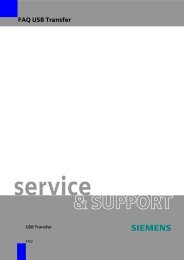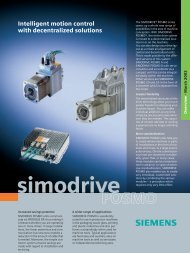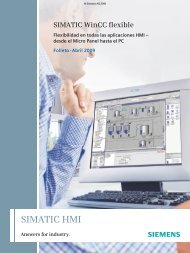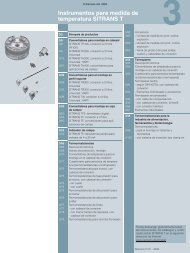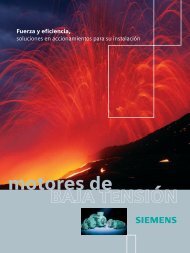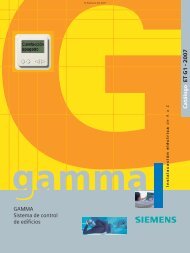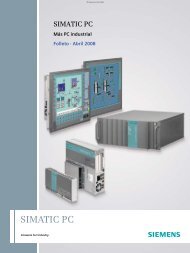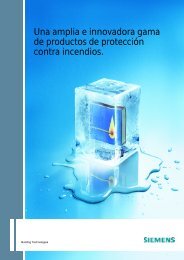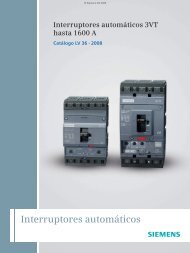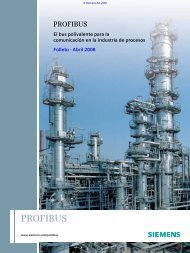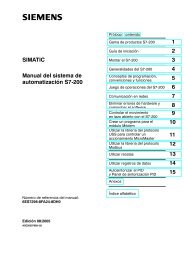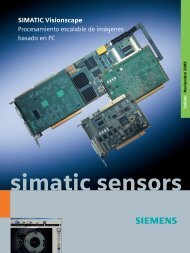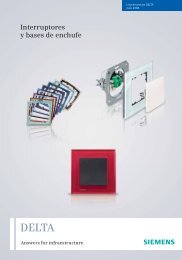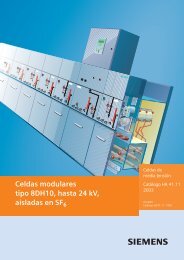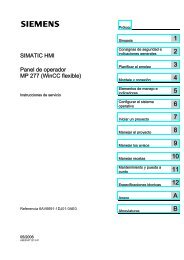Instrumentos para medida de caudal SITRANS F - GRUP DAP
Instrumentos para medida de caudal SITRANS F - GRUP DAP
Instrumentos para medida de caudal SITRANS F - GRUP DAP
You also want an ePaper? Increase the reach of your titles
YUMPU automatically turns print PDFs into web optimized ePapers that Google loves.
4<br />
<strong>Instrumentos</strong> <strong>para</strong> <strong>medida</strong> <strong>de</strong> <strong>caudal</strong> <strong>SITRANS</strong> F<br />
<strong>SITRANS</strong> F C<br />
Información <strong>de</strong>l sistema<br />
<strong>de</strong> los <strong>caudal</strong>ímetros másicos Coriolis<br />
Montaje: tramos rectos <strong>de</strong> entrada y salida<br />
• Para el <strong>caudal</strong>ímetro másico no se requieren secciones <strong>de</strong><br />
admisión rectas <strong>para</strong> adaptar el <strong>caudal</strong>. Es imprescindible<br />
asegurar que las válvulas, corre<strong>de</strong>ras, mirillas etc. no estén<br />
sometidas a efectos <strong>de</strong> cavitación y que el <strong>caudal</strong>ímetro no<br />
las ponga en vibración.<br />
Indicaciones con respecto a la estructura <strong>de</strong>l sistema<br />
• Las burbujas <strong>de</strong> gas contenidas en el líquido pue<strong>de</strong>n causar<br />
errores <strong>de</strong> <strong>medida</strong>, sobre todo en las <strong>medida</strong>s <strong>de</strong> <strong>de</strong>nsidad.<br />
Por ese motivo, el <strong>caudal</strong>ímetro no <strong>de</strong>be instalarse en el punto<br />
más alto <strong>de</strong>l sistema.<br />
Más bien será conveniente montarlo en las secciones más<br />
profundas <strong>de</strong> la tubería, p.ej. en el fondo <strong>de</strong> una sección con<br />
forma <strong>de</strong> U.<br />
• Evítense los tubos <strong>de</strong>scen<strong>de</strong>ntes largos <strong>de</strong>trás <strong>de</strong>l <strong>caudal</strong>ímetro,<br />
<strong>para</strong> evitar que el tubo <strong>de</strong> <strong>medida</strong> llegue a vaciarse.<br />
• A<strong>de</strong>más <strong>de</strong>be evitarse que el <strong>caudal</strong>ímetro haga contacto<br />
con otros objetos. No se admiten montajes adosados en la<br />
caja.<br />
• Si la sección <strong>de</strong> la tubería <strong>de</strong> conexión exce<strong>de</strong> el diámetro nominal<br />
<strong>de</strong>l sensor <strong>de</strong> <strong>medida</strong>, entonces podrán instalarse los<br />
reductores estándar correspondientes.<br />
• Las vibraciones intensas que puedan presentarse en la tubería<br />
<strong>de</strong>ben amortiguarse en caso dado por medio <strong>de</strong> elementos<br />
amortiguadores elásticos. Los dispositivos amortiguadores<br />
<strong>de</strong>ben instalarse fuera <strong>de</strong>l tramo sustentado con el<br />
<strong>caudal</strong>ímetro y fuera <strong>de</strong>l tramo que se encuentra entre los dispositivos<br />
<strong>de</strong> cierre. Evítese la conexión directa <strong>de</strong> elementos<br />
flexibles en el sensor <strong>de</strong> <strong>medida</strong>.<br />
• Debe quedar asegurado que los gases disueltos, tal y como<br />
están contenidos en muchos líquidos, no se <strong>de</strong>sgasifiquen.<br />
La presión <strong>de</strong> retención en la salida <strong>de</strong>bería ascen<strong>de</strong>r a 0,1 a<br />
0,2 bares (0.5 a 3 psi), como mínimo.<br />
• En caso <strong>de</strong> un vacío en el tubo <strong>de</strong> <strong>medida</strong> o en aplicaciones<br />
con líquidos con bajo punto <strong>de</strong> ebullición <strong>de</strong>be evitarse el servicio<br />
con presiones inferiores al nivel <strong>de</strong> la presión <strong>de</strong> vapor.<br />
• El sensor no <strong>de</strong>be instalarse en las proximida<strong>de</strong>s <strong>de</strong> campos<br />
electromagnéticos intensos, p.ej. motores, bombas, convertidores<br />
etc.<br />
• Instalando varios flujómetros en una tubería o en varias tuberías<br />
conectadas entre sí, los sensores <strong>de</strong>berían disponerse lejos<br />
el uno <strong>de</strong>l otro o bien las tuberías <strong>de</strong>berían <strong>de</strong>sacoplarse,<br />
<strong>para</strong> evitar el efecto "Cross Talk" (errores <strong>de</strong> diafonía).<br />
Ajuste <strong>de</strong>l cero<br />
• Para ajustar el cero en condiciones <strong>de</strong> servicio <strong>de</strong>be haber la<br />
posibilidad <strong>de</strong> poner el <strong>caudal</strong> a "CERO" mientras el tubo <strong>de</strong><br />
<strong>medida</strong> esté completamente lleno. Si no es posible <strong>de</strong>tener el<br />
proceso, la instalación <strong>de</strong> una tubería <strong>de</strong> <strong>de</strong>rivación será la<br />
óptima solución. Para obtener <strong>medida</strong>s precisas es imprescindible<br />
que durante el ajuste <strong>de</strong>l cero no se encuentren burbujas<br />
<strong>de</strong> gas en el <strong>caudal</strong>ímetro. A<strong>de</strong>más, la presión y la temperatura<br />
en el tubo <strong>de</strong> <strong>medida</strong> <strong>de</strong>ben correspon<strong>de</strong>r a los<br />
valores en régimen <strong>de</strong> servicio.<br />
4/116<br />
Siemens FI 01 · 2009<br />
© Siemens AG, 2009<br />
■ Datos técnicos<br />
Caudalímetros - Incertidumbre y datos<br />
Para garantizar la precisión <strong>de</strong> la <strong>medida</strong> <strong>de</strong> <strong>caudal</strong> en modo<br />
permanente es necesario calibrar los <strong>caudal</strong>ímetros. La calibración<br />
se realiza en los establecimientos <strong>de</strong> SIEMENS, acreditados<br />
por DANAK o UKAS según ISO/IEC 17025.<br />
Las entida<strong>de</strong>s acreditadoras DANAK y UKAS han firmado el<br />
Convenio ILAC MRA (International Laboratory Accreditation<br />
Corporation - Mutual Recognition Arrangement). Por lo tanto, la<br />
acreditación garantiza la trazabilidad a nivel internacional y el<br />
reconocimiento <strong>de</strong> los resultados <strong>de</strong> prueba en 39 países <strong>de</strong>l<br />
mundo, incluidos los EE.UU. (trazabilidad NIST).<br />
Cada sensor se suministra con el correspondiente certificado<br />
<strong>de</strong> calibración y con los datos <strong>de</strong> calibración que vienen <strong>de</strong>positados<br />
en el módulo <strong>de</strong> memoria SENSORPROM.<br />
Sensor MASS 2100 y transmisor MASS 6000<br />
1,0<br />
0,5<br />
0,1<br />
-0,1<br />
-0,5<br />
-1,0<br />
error en % <strong>de</strong>l actual <strong>caudal</strong> másico con una certeza <strong>de</strong> 95% (probabilidad)<br />
5% 25% 50%<br />
5 % 50 % 100 %<br />
kg/h (lb/h) kg/h (lb/h) kg/h (lb/h)<br />
DI 1,5 (1/16") 1 (2.2) 32,5 (71.6) 65 (140)<br />
DI 3 (1/8") 12 (26) 125 (275) 250 (550)<br />
DN 4 (1/6") 17,5 (38) 175 (386) 350 (770)<br />
DI 6 (¼") 50 (110) 500 (1 102) 1 000 (2 200)<br />
DI 15 (½") 280 (617) 2 800 (6 173) 5 600 (12 345)<br />
DI 25 (1") 1 250 (2 756) 12 500 (27 558) 25 000 (55 100)<br />
DI 40 (1½") 2 600 (5 732) 26 000 (57 320) 52 000 (114 600)<br />
• En caso <strong>de</strong> <strong>caudal</strong>es <strong>de</strong> > 5 % <strong>de</strong> la tasa <strong>de</strong>l <strong>caudal</strong> máximo<br />
<strong>de</strong>l sensor, el error podrá verse directamente en la curva.<br />
• En caso <strong>de</strong> <strong>caudal</strong>es <strong>de</strong> < 5 % <strong>de</strong> la tasa <strong>de</strong>l <strong>caudal</strong> máximo<br />
<strong>de</strong>l sensor, el error <strong>de</strong>berá <strong>de</strong>terminarse en base a la fórmula<br />
<strong>de</strong> cálculo indicada.<br />
• La característica <strong>de</strong> errores se <strong>de</strong>spren<strong>de</strong> <strong>de</strong> la siguiente fórmula:<br />
E = ± (0.10) 2 +<br />
( ) 2<br />
z x 100<br />
qm<br />
E = error [%]<br />
Z = error <strong>de</strong> cero [kg/h]<br />
qm = <strong>caudal</strong> másico [kg/h]<br />
<strong>caudal</strong> másico actual<br />
75%<br />
100%<br />
FSO<br />
(<strong>caudal</strong> máx.<br />
<strong>de</strong>l sensor)<br />
Tipo <strong>de</strong> sensor FC300 MASS 2100<br />
Diámetro nominal <strong>de</strong>l sensor DN 4 (1/6") DI 1,5 (1/16") DI 3 (1/8") DI 6 (¼") DI 15 (½") DI 25 (1") DI 40 (1½")<br />
Número <strong>de</strong> tubos <strong>de</strong> <strong>medida</strong><br />
Caudal másico<br />
1 1 1 1 1 1 1<br />
Error <strong>de</strong> linealidad % <strong>de</strong>l <strong>caudal</strong> 0,10 0,10 0,10 0,10 0,10 0,10 0,10<br />
Error <strong>de</strong> reproducibilidad % <strong>de</strong>l <strong>caudal</strong> 0,05 0,05 0,05 0,05 0,05 0,05 0,05<br />
Error <strong>de</strong> cero máx.<br />
Densidad<br />
[kg/h] 0,010 0,001 0,010 0,050 0,200 1.500 6.000<br />
Desviación <strong>de</strong> espesor [g/cm3 ] 0,0015 0,001 0,0015 0,0015 0,0005 0,0005 0,0005<br />
Error <strong>de</strong> reproducibilidad [g/cm 3 ] 0,0002 0,0002 0,0002 0,0002 0,0001 0,0001 0,0001<br />
Rango [g/cm3 ] 0 ... 2,9 0 ... 2,9 0 ... 2,9 0 ... 2,9 0 ... 2,9 0 ... 2,9 0 ... 2,9



